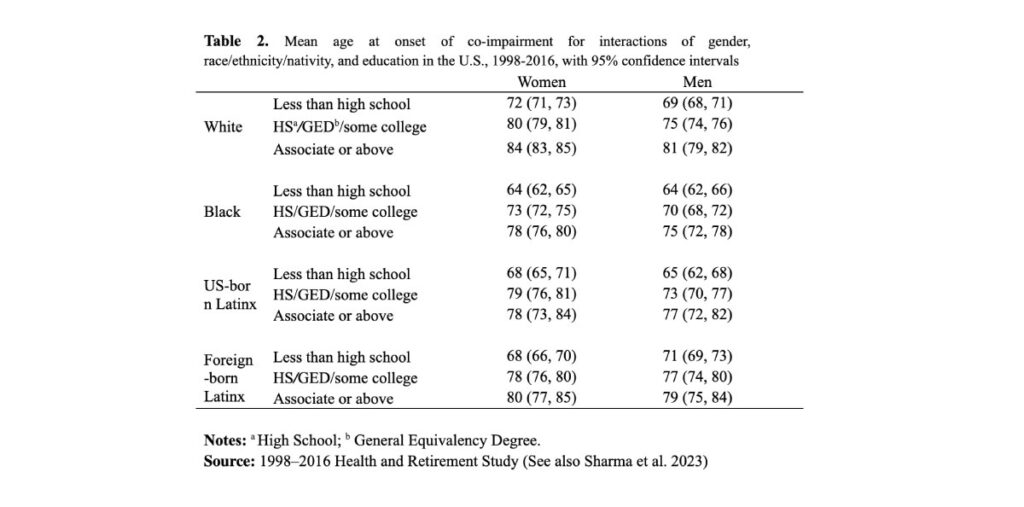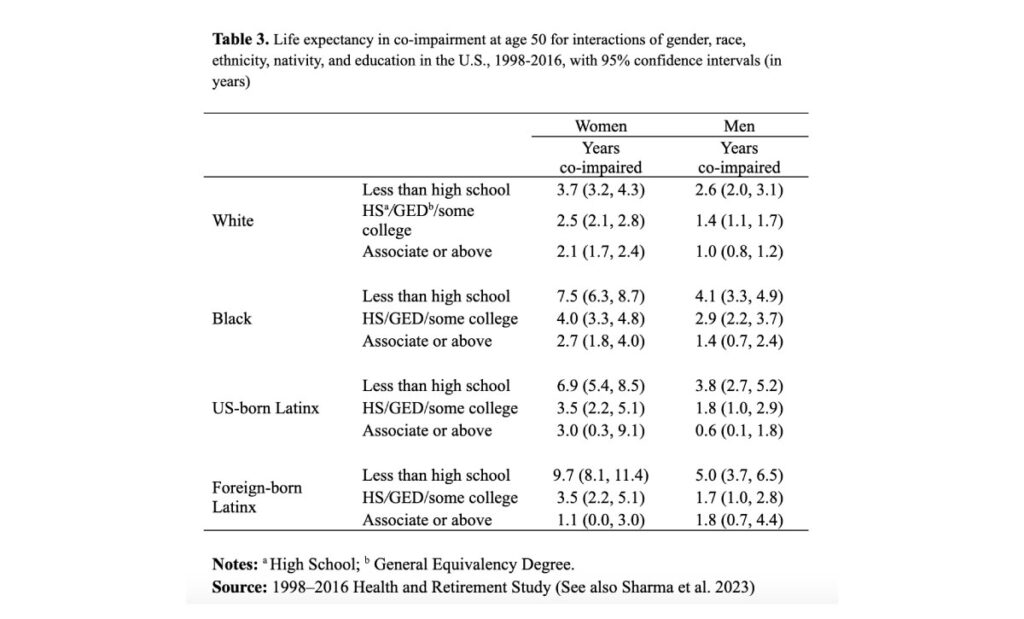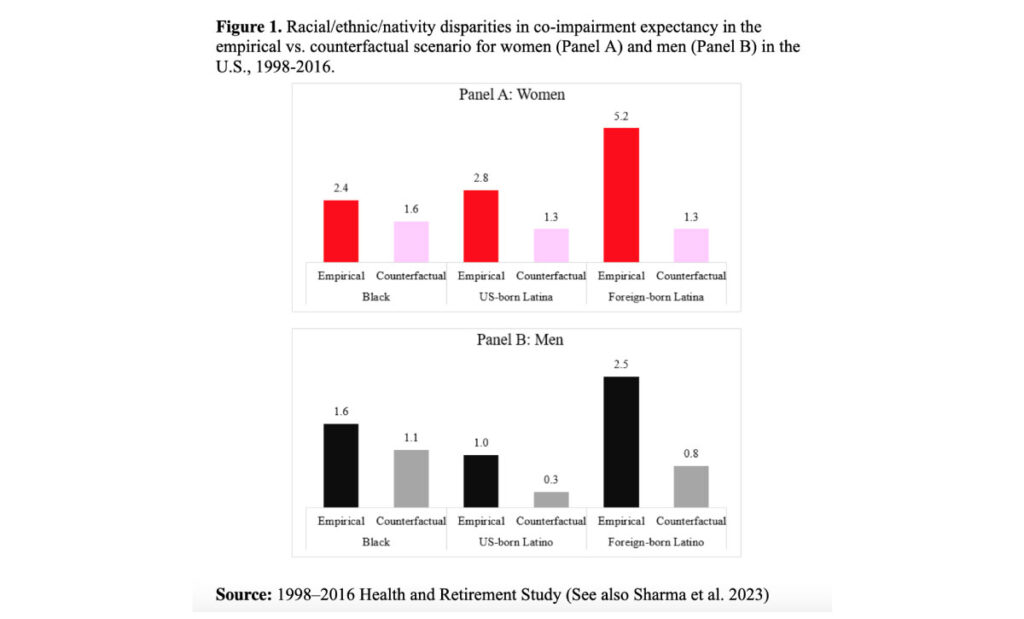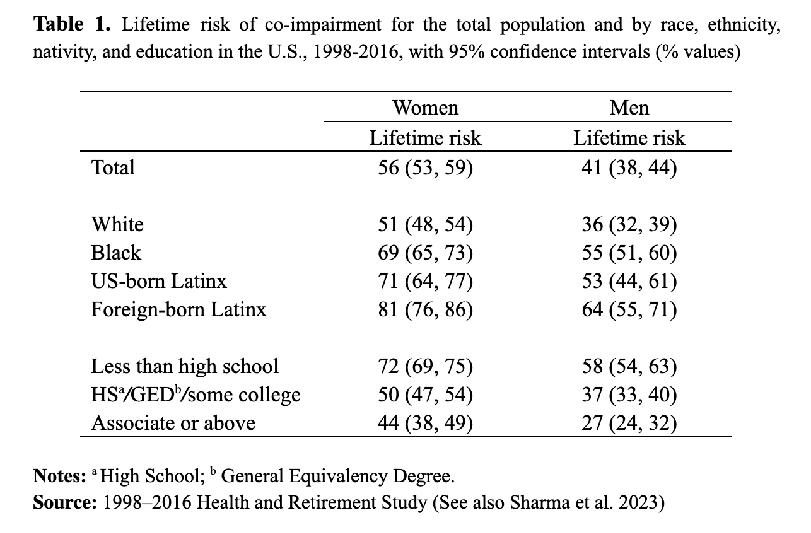The under-investigated issue of co-impairment (cognitive impairment and limitations in basic activities of daily living) is more prevalent than commonly believed. Shubhankar Sharma, Jo Mhairi Hale, Mikko Myrskylä and Hill Kulu describe the case of the U.S. and underline the profound health inequalities across some of its population subgroups.
The U.S. is experiencing considerable population aging. While older adults constituted 17% of the total U.S. population in 2020, the share is predicted to reach 22% by 2040 (Vespa et al. 2018). Population aging poses serious challenges as health declines with increasing age, sometimes to the point where independent living becomes impossible.
Co-impairment
Extensive research has been conducted to understand co-impairment, the joint burden of cognitive impairment and limitations in basic activities of daily living such as walking, dressing, and eating. Co-impairment is considerably more detrimental to the affected individuals as well as to the caregivers’ health and well-being than either burden experienced separately (Riffin et al. 2017; Yu et al. 2017). However, no study has investigated the risk of experiencing co-impairment in one’s lifetime: at what age and for how long co-impairment is experienced (expectancy).
Over one million older adults experience co-impairment in the U.S. (Riffin et al. 2017) and, with rapid population aging, this number is likely to increase. In recent research (Sharma et al. 2023), we examined the burden of co-impairment among older individuals in the U.S. using data from the Health and Retirement Study, 1998-2016, and multistate models. In addition to estimating the widely used metric of expectancy, we also estimated the lifetime risk and mean age at onset of co-impairment by gender, race/ethnicity/nativity, and educational level, as health disparities are high in the U.S. (Hayward et al. 2014).
Table 1 presents the main results. Overall, 41% of men and 56% of women aged 50 are expected to experience co-impairment in their remaining life expectancy. Blacks, foreign- and U.S.-born people of Latin American origin or descent (Latinx), and the lowest educated experience substantially greater lifetime risk of co-impairment than Whites and the highest educated, regardless of gender.
Table 2 presents the average age at onset of co-impairment for racial/ethnic/nativity subpopulations by educational attainment. Black women and men pay the highest penalty for having the lowest level of education. They have the youngest co-impairment onset (at age 64 years), resulting in dramatic disparities of about two decades compared with the highest educated Whites.

Table 3 shows the co-impairment expectancies for all the racial/ethnic/nativity subgroups by educational attainment. In each racial/ethnic subpopulation, those with the lowest education have the longest co-impairment expectancy. In particular, the lowest educated foreign-born Latinx live the longest in co-impairment (men: 5.0 years, women: 9.7 years).

Educational intervention: a potential way to narrow the disparities
Figure 1 shows the racial/ethnic/nativity disparities in co-impairment expectancy (e.g., between Blacks and Whites) in the counterfactual and empirical scenarios. In the counterfactual scenario, educational inequalities across race/ethnicity/nativity are eliminated. We assign the educational distribution of Whites to Blacks and Latinx and recalculate their expectancies, with differences from the Whites that, not surprisingly, shrink.

The U.S. has a long road ahead to attain health equity
Being co-impaired poses serious disadvantages for the affected individuals, family members, caregivers, and society. Our study provides novel insights into its burden and offers evidence of dramatic disparities in the older U.S. population. We find that older women, Blacks, U.S.- and foreign-born Latinx, and less than high school educated adults experience a considerably greater burden of co-impairment. For instance, we find a difference of almost nine years in co-impairment expectancy between the highest educated White men and lowest educated foreign-born Latinas aged 50.
These findings may help health planners to identify the vulnerable subgroups of caregivers who may need additional resources or support. Particularly, Blacks and Latinx rely more heavily on family members for care and support than Whites (Rote and Moon 2018). Since Blacks, Latinx, and the lowest educated have an earlier onset of co-impairment and live considerably longer in co-impairment than others, their caregivers are subject to greater strain and are themselves at greater risk of poor health in the future.
Maintaining the health and well-being of the growing older population has become a public health priority in the U.S., a serious challenge for health planners and policymakers, also considering that the shares of the most vulnerable groups, Latinx and Blacks, are increasing (Vespa et al. 2018). The considerable disparities across subpopulations in co-impairment indicate that the U.S. has a long road ahead to attain health equity. Nevertheless, at least 31% of the racial/ethnic/nativity disparities in co-impairment expectancy are attributable to educational inequalities. This promising finding emphasizes the importance of an educational intervention in narrowing the future racial/ethnic/nativity disparities in health.
References
- Hayward, M. D., Hummer, R. A., Chiu, C. T., González-González, C., & Wong, R. (2014). Does the Hispanic Paradox in U.S. Adult Mortality Extend to Disability?. Population Research and Policy Review, 33(1), 81–96. https://doi.org/10.1007/s11113-013-9312-7
- Riffin, C., Van Ness, P. H., Wolff, J. L., & Fried, T. (2017). Family and Other Unpaid Caregivers and Older Adults with and without Dementia and Disability. Journal of the American Geriatrics Society, 65(8), 1821–1828. https://doi.org/10.1111/jgs.14910
- Rote, S. M., & Moon, H. (2018). Racial/Ethnic Differences in Caregiving Frequency: Does Immigrant Status Matter?. The Journals of Gerontology. Series B, Psychological sciences and social sciences,73(6), 1088–1098. https://doi.org/10.1093/geronb/gbw106
- Sharma, S., Hale, J. M., Myrskylä, M., & Kulu, H. (2023). Racial, Ethnic, Nativity, and Educational Disparities in Cognitive Impairment and Activity Limitations in the United States, 1998–2016. Demography, 60(5), 1441-1468.
- Vespa, J., Armstrong, D. M., and Medina, L. (2018). Demographic turning points for the United States: Population projections for 2020 to 2060. Washington, DC: US Department of Commerce, Economics and Statistics Administration, US Census Bureau. Retrieved from https://www.census.gov/content/dam/Census/library/publications/2020/demo/p25-1144.pdf
- Yu, W. C., Chou, M. Y., Peng, L. N., Lin, Y. T., Liang, C. K., & Chen, L. K. (2017). Synergistic effects of cognitive impairment on ADL disability in all-cause mortality among men aged 80 years and over: results from longitudinal older veterans study. PLoS One, 12(7), e0181741. https://doi.org/10.1371/journal.pone.0181741


No comments:
Post a Comment